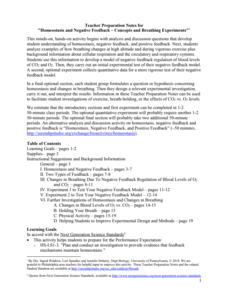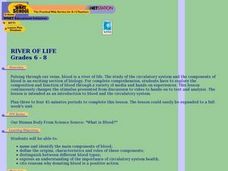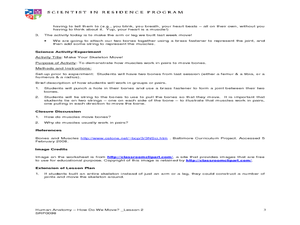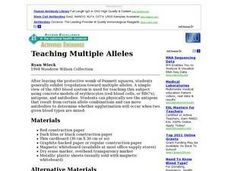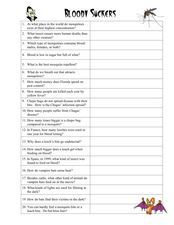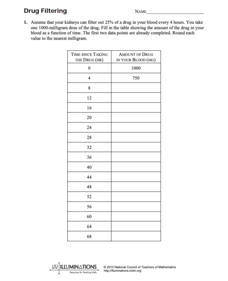Curated OER
Heart Disease & Stroke
Young scholars study heart disease and how to prevent it. For this investigative lesson students list heart disease and stroke risk factors.
Curated OER
Young Blood
Students take a closer look at youth crime. In this current events lesson, students research the listed Web sites that include information about British teen violence and poverty statistics in the nation. Students then discuss how to...
Curated OER
All About Blood and the Heart (Human Body for Children)
In this anatomy worksheet, students learn about the heart and it's characteristics. Students monitor their heartbeat in an experiment and then answer a series of questions about what they found.
Teach Engineering
The Mighty Heart
Have your class follow the step-by-step directions in this resource to dissect a sheep heart and gain a better understanding of this amazing organ. Working in small groups, pupils look for specific parts of the heart during their...
Teach Engineering
Heart to Heart
Begin a unit on the heart, the parts and the function of the heart, and about heart disease with a resource that includes a lecture, a PowerPoint presentation, and research information. The lesson is the first of a four-part series...
Teach Engineering
Model Heart Valves
Small groups use the knowledge learned about the heart to design and build a prototype of an artificial heart valve. The teams demonstrate the functionality of their valve. They are also responsible for creating a pamphlet that describes...
Serendip
Homeostasis and Negative Feedback – Concepts and Breathing Experiments
More asthma attacks happen at higher altitudes, but why? Scholars complete worksheets, learning about homeostasis and feedback related to breathing. Then, they work in small groups to experiment with breathing in limited amounts of...
Curated OER
AP: Chapter 45: Chemical Regulation & Communication - Hormones and the Endocrine System
Infuse your AP biologists with the details of the endocrine system. This six-page worksheet queries learners thoroughly about gland structure and hormone function. Ms. Foglia, the author, has not left anything out of this resource,...
Curated OER
ESL Picture/Idiom Matching Worksheet
In this ESL picture to idiom matching activity, students examine 7 small clip art images before matching them to the idioms they best represent. They work with idioms such as "blood is thicker than water," and "as you make your bed, so...
Curated OER
Animal Survival - Water and Waste
Here is a very simple set of slides to complement your lecture about the importance of water for animals. It includes a table of where we gain liquid from, the chemical reaction for aerobic respiration, how we lose water, and how ADH and...
Curated OER
Breathing and Holding Your Breath
Five questions are presented and answered as a means of delivering information on the respiratory system. Using red and blue game chips, physiology learners model the movement of blood through the lungs. Groups of learners time how long...
Curated OER
Themes and Motifs in Macbeth Act Five
How do themes and motifs build and develop through Act Five of Macbeth? With this two-page activity, readers record quotations that represent themes like ambition, conscience, and manhood. In addition, they speak to symbols like blood,...
Science 4 Inquiry
Genetics, Genetics, and More Genetics: Exploring Independent Assortment and Non-Mendelian Genetics
Two individuals share 99.9 percent of their genetic codes, yet diversity is observed everywhere. Young scientists learn about diversity through hands-on activities and an experiment. They apply the concepts of independent assortment and...
Curated OER
What Increases the Risk of Cardiovascular Disease?
Students analyze the risk factors for cardiovascular disease and classify them according to whether or not they are controllable. They discover how to reduce the probability of high blood pressure through diet and exercise.
Curated OER
Lub Dub
Students name the vessels and parts of the heart. They trace the path of blood through the heart. Students examine the function of the circulatory system. They recognize the differences between a hear when the body is at rest opposed to...
Curated OER
River of Life
Students explore the composition and function of blood through a variety of media and hands-on experiences. This lesson is a very good introduction to blood and the circulatory system.
Curated OER
Human Anatomy - How Do We Move?
Fifth graders discover how blood moves around the body. In this circulatory system lesson, 5th graders feel their pulse before and after exercise. Students count their heart rate. Students use the scientific method to record...
Curated OER
What's New With Dinosaurs?
Young scholars examine how scientists are at odds on whether or not dinosaurs were warm or cold blooded. In this dinosaurs lesson students divide into groups and research the evidence that supports each side.
Curated OER
What Does The Heart Do?
Students study the relationship between the heart and circulation. In this circulatory system lesson, students read the "What Am I?" article about the heart and discuss. Students draw a heart and lungs, discover how blood is pumped...
Curated OER
Teaching Multiple Alleles
High schoolers view a simple ABO blood system for the introduction of this subject using concrete models of eythrocytes (red blood cells, or RBC's), antigens, and antibodies. They can physically see the antigens that result from certain...
Curated OER
Bloody Suckers
In this blood sucking animals learning exercise, students answer 20 questions about leeches, mosquitoes, Chepo bugs, and bats which all suck blood to transmit diseases or get nutrients.
National Council of Teachers of Mathematics
Drug Filtering
In this chemistry instructional activity, learners calculate the amount of drug found in someones blood based on how long they have been taking the drug. There are 5 questions.
Curated OER
Mountaineering: How Our Bodies Acclimatize
In this mountaineering and acclimatization worksheet, students read about the changes that take place in the blood as the body acclimatizes to high altitude. They answer three critical thinking questions about acclimatization.
Curated OER
Mission Possible
Students, in teams, solve a crime using forensic lab techniques. They apply lab techniques to a real life situation using a crime scenario that takes place on campus. Sample activities include Blood, Fiber, and Hair Lab.
Other popular searches
- In Cold Blood
- Blood Pressure
- Blood Types
- Blood Vessels
- Blood Flow
- Blood Platelets
- Blood Cells
- Forensic Science Blood Type
- Blood Circulation
- Red & White Blood Cells
- Blood Typing
- Cold Blooded






